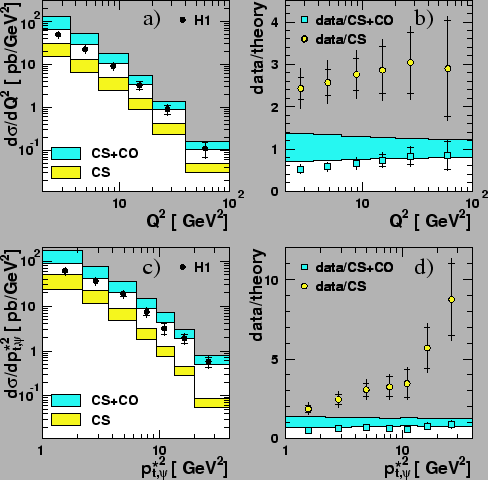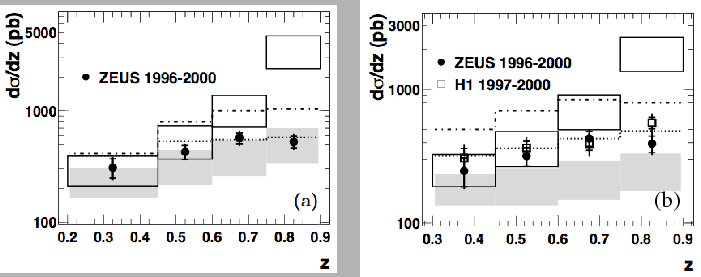 |
 |
The analysis of leptoproduction at finite ![]() has experimental and
theoretical advantages in comparison with the analysis of photoproduction.
At high
has experimental and
theoretical advantages in comparison with the analysis of photoproduction.
At high ![]() , theoretical uncertainties in the models
decrease and resolved-photon processes are expected to be negligible.
Furthermore, the distinct signature of the scattered lepton makes the inelastic
process easier to detect. However, due to the steeply falling
, theoretical uncertainties in the models
decrease and resolved-photon processes are expected to be negligible.
Furthermore, the distinct signature of the scattered lepton makes the inelastic
process easier to detect. However, due to the steeply falling ![]() dependence
the data are more limited statistically.
dependence
the data are more limited statistically.
The cross section for ![]() production in deep-inelastic
production in deep-inelastic ![]() scattering
at HERA was calculated in the NRQCD factorization approach at leading order
in
scattering
at HERA was calculated in the NRQCD factorization approach at leading order
in ![]() taking into account
diagrams of the type ``
taking into account
diagrams of the type ``
![]() '' [193]
using the matrix elements as determined in [183] and the
MRST98LO [73] and CTEQ5L [72] parton distributions.
In fig.45, the results of this calculation are plotted as
a function of
'' [193]
using the matrix elements as determined in [183] and the
MRST98LO [73] and CTEQ5L [72] parton distributions.
In fig.45, the results of this calculation are plotted as
a function of ![]() and
and
![]() , along with the H1 data
[30]. The NRQCD results that are shown in
fig.45 include the contributions from the color-octet
channels
, along with the H1 data
[30]. The NRQCD results that are shown in
fig.45 include the contributions from the color-octet
channels ![]() ,
,
![]() ,
, ![]() , as well as from
the color-singlet channel
, as well as from
the color-singlet channel ![]() . The contribution of the
color-singlet channel is also shown separately. The values of the NRQCD
matrix elements were determined from the distribution of transverse
momenta of
. The contribution of the
color-singlet channel is also shown separately. The values of the NRQCD
matrix elements were determined from the distribution of transverse
momenta of ![]() mesons produced in
mesons produced in ![]() collisions [183].
The bands include theoretical uncertainties, which originate from the
uncertainty in the charm-quark mass
collisions [183].
The bands include theoretical uncertainties, which originate from the
uncertainty in the charm-quark mass
![]() GeV, the variation
of renormalization and factorization scales by factors 1/2 and 2, and
the uncertainties in the NRQCD matrix elements, all of which result
mainly in normalization uncertainties that do not affect the shapes of
the distributions.
GeV, the variation
of renormalization and factorization scales by factors 1/2 and 2, and
the uncertainties in the NRQCD matrix elements, all of which result
mainly in normalization uncertainties that do not affect the shapes of
the distributions.
 |
Figure 46 shows the differential electroproduction
cross sections for ![]() mesons from ZEUS [33] and
H1 [30] as function of
mesons from ZEUS [33] and
H1 [30] as function of ![]() .
The data are compared with predictions in the framework of
NRQCD [193] and also with predictions
in the
.
The data are compared with predictions in the framework of
NRQCD [193] and also with predictions
in the ![]() factorization approach in which only
the color-singlet contribution (CS) is
included [104,190].
The uncertainties in the NRQCD calculations are indicated in
fig.46 as bands.
The agreement with the color singlet model (CS),
seen in fig.46a, deteriorates when
the cut
factorization approach in which only
the color-singlet contribution (CS) is
included [104,190].
The uncertainties in the NRQCD calculations are indicated in
fig.46 as bands.
The agreement with the color singlet model (CS),
seen in fig.46a, deteriorates when
the cut
![]() GeV is applied
(fig.46b). This cut is justified, however, as
towards small
GeV is applied
(fig.46b). This cut is justified, however, as
towards small
![]() , perturbation theory
becomes increasingly unreliable due to collinear singularities
for the contributions
, perturbation theory
becomes increasingly unreliable due to collinear singularities
for the contributions
![]() with
with
![]() =
=
![]() and
and
![]() [193].
[193].